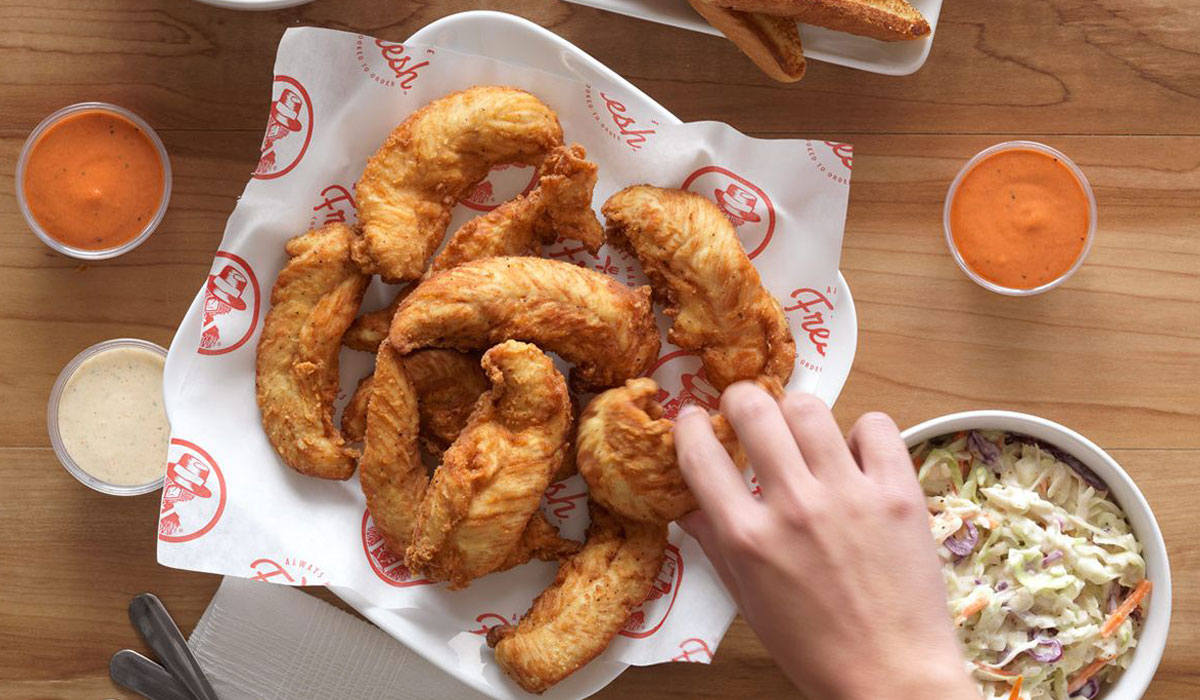Slim Chickens COO Sam Rothschild says that when COVID-19 hit, the brand immediately turned to offense.
Dining rooms may have been closed, but the company knew there was business to be had—customers still needed to eat. Franchisees, who received a 1.5 percent reduction in royalties for six weeks, looked to the company for leadership, Rothschild says.
Within the first week of recognizing the pandemic’s impact, Slim Chickens put standard operating procedures in place to enact curbside service. Units around the country rearranged their parking lots—staffing, staging, and packaging—to streamline the shift to curbside. The brand then pivoted its attention to drive-thru, ensuring throughput was effective enough to support the increased demand. The company spent hundreds of thousands of dollars on marketing for curbside and drive-thru and pushed messaging on its app, which has more than 330,000 users or “Slimthusiasts.”
READ MORE:
Why Slim Chickens is one of the top 10 franchise deals of 2020
Where the road to 600 locations began
The chain’s proactive approach led to profitable results. Same-store sales are growing more than 20 percent on a rolling basis, and from a year-to-date perspective, comps are positive. Online ordering increased well over 300 percent, delivery bumped about 30 percent, albeit on a relatively small basis, and drive-thru leaped anywhere from 60 to 80 percent year-over-year.
“Without a dining room to service, fundamentally, it was more effective for us to focus the majority of our efforts just servicing the drive-thru,” Rothschild says. “So what we found is, with focus and staffing, we were able to make the drive-thru go more effectively and efficiently than we’ve ever seen before with our brand.”
“ … Some of our restaurants quite honestly were seeing some of the highest sales volumes they’ve ever done,” he continues.
Slim Chickens leaned heavily into its drive-thru, but did so without having to slice the menu. Rothschild says employees were placed outside with tablets, protective gear, and portable menu boards to greet cars faster.
“We were on a conference call on a pretty regular basis with our franchisees and everybody was sharing best practices to what they saw, and we quickly learned from each other what was working around the country,” Rothschild says. “… We didn’t pare back the menu at all. I see that in other restaurants as I’ve been going around. I understand it, especially for the sit-down restaurants, but for us, we just stayed focused on our entire menu. And in the middle of it, at some restaurants we were rolling product out. We were completing the roll out of our milkshake program.”
Looking ahead toward the rest of the summer, Slim Chickens—which oversees more than 100 locations—is approaching the reopening of dining rooms very carefully.
Customer and employee safety are of utmost concern, Rothschild says. There are some franchisees that have decided to keep dining rooms closed even though they have the green light; company-run stores have done the same in a few markets. Even when governments say a restaurant can allow 50 to 60 percent of capacity, social distancing requirements don’t afford locations to have many tables, Rothschild explains.
“So even when they say you can go from one-third to 60 percent or whatever, it really doesn’t do much for the dining room,” Rothschild says. “What I have found personally as I’ve been around in the restaurants, there is a desire for people to want to come in and dine in. So it’s been interesting to watch how customers want to get out and get back into restaurants and just get on with things. But we’re following all the guidelines. We’re doing the best we can. We’ve put out policies about how to do things in the restaurants … Whatever [governments] say we got to do, we got to do it.”
Before the pandemic, Slim Chickens planned to open more than 30 units in 2020. Those plans have been tweaked, but not significantly. Rothschild still expects more than 20 openings this year. None of the planned U.S. locations came off the board; some were just pushed back because certain states didn’t allow construction for a period. The better chicken brand recently celebrated an opening in Panama City, Florida, on June 25—the restaurant’s first location in the Sunshine state. The brand has an overall goal to reach 600 units by 2025.
Investment in the brand hasn’t waned either. Slim Chickens closed on five development agreements it was working on prior to the crisis.
Rothschild says prospective franchisees have been hesitant to travel to discovery days, but when matters improve, there are many who want to visit. The COO says it’s been an encouraging sign for the brand and has brought positive momentum.
“People understand that this is a short-term issue,” Rothschild says. “Short-term is a relative point of view if you look at things in years and years and years. But people believe in the brand and what we’re doing, so it hasn’t really stopped our development pipeline of having franchisees coming into the brand. For us, we’ve been very enthusiastic about that.”
Rothschild says the biggest things to watch will be the countless closures of restaurants due to the effects of COVID. On the opportunistic side, he notes that valuable real estate will come available, and Slim Chickens thinks it can convert closing restaurants into its brand—that’s a key strategic development strategy.
As for the industry overall, he says it’s too early to tell. He does know that demand for dining won’t decrease, and with a 10 to 15 percent closure rate, that demand is going to shift to stores that are open. His expectation is there will be brands that benefit from that newfound demand, and he believes Slim Chickens is one of them.
“We’re very optimistic about the future. Not only our brand, but the industry once this all shakes out,” Rothschild says



